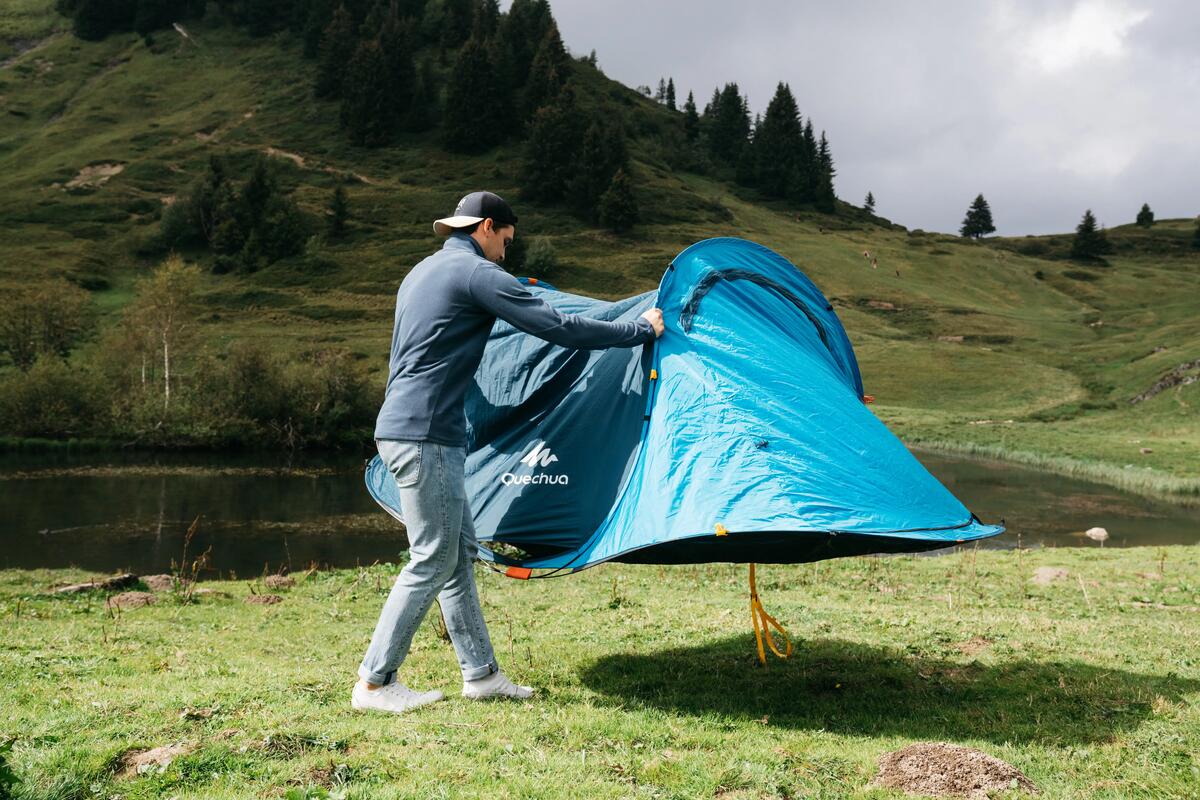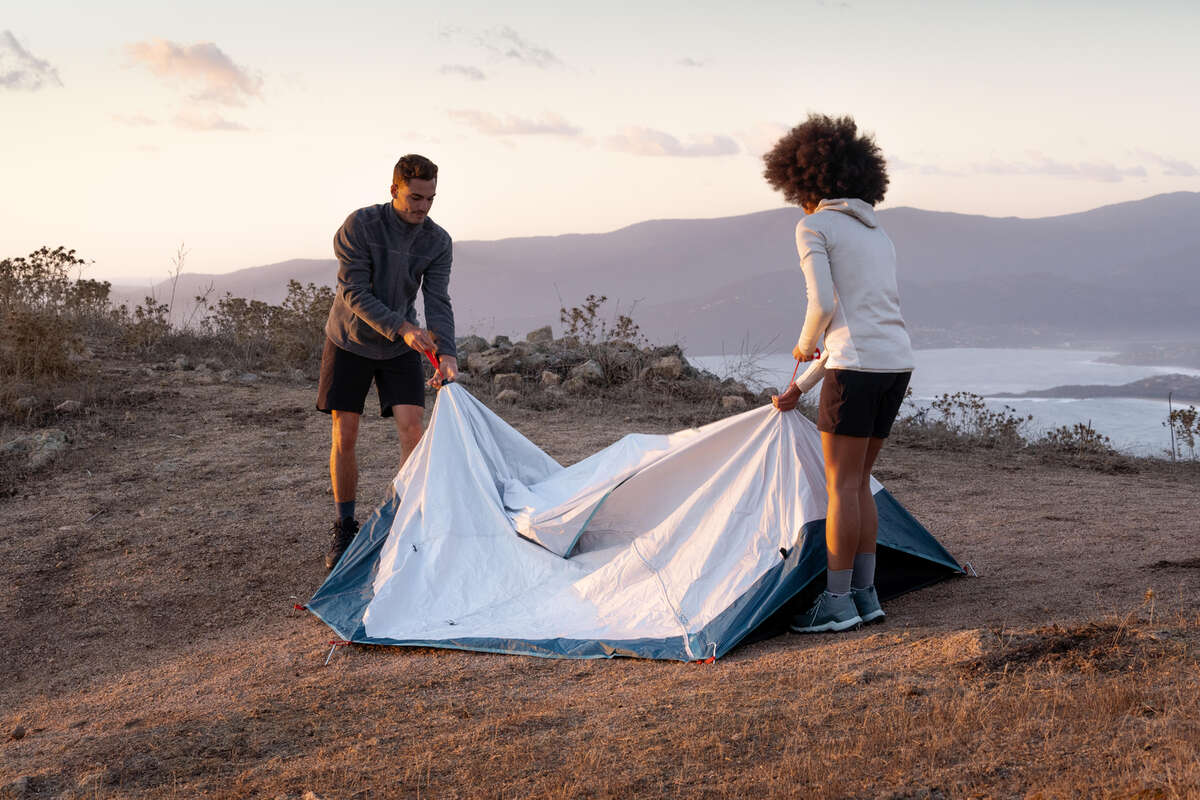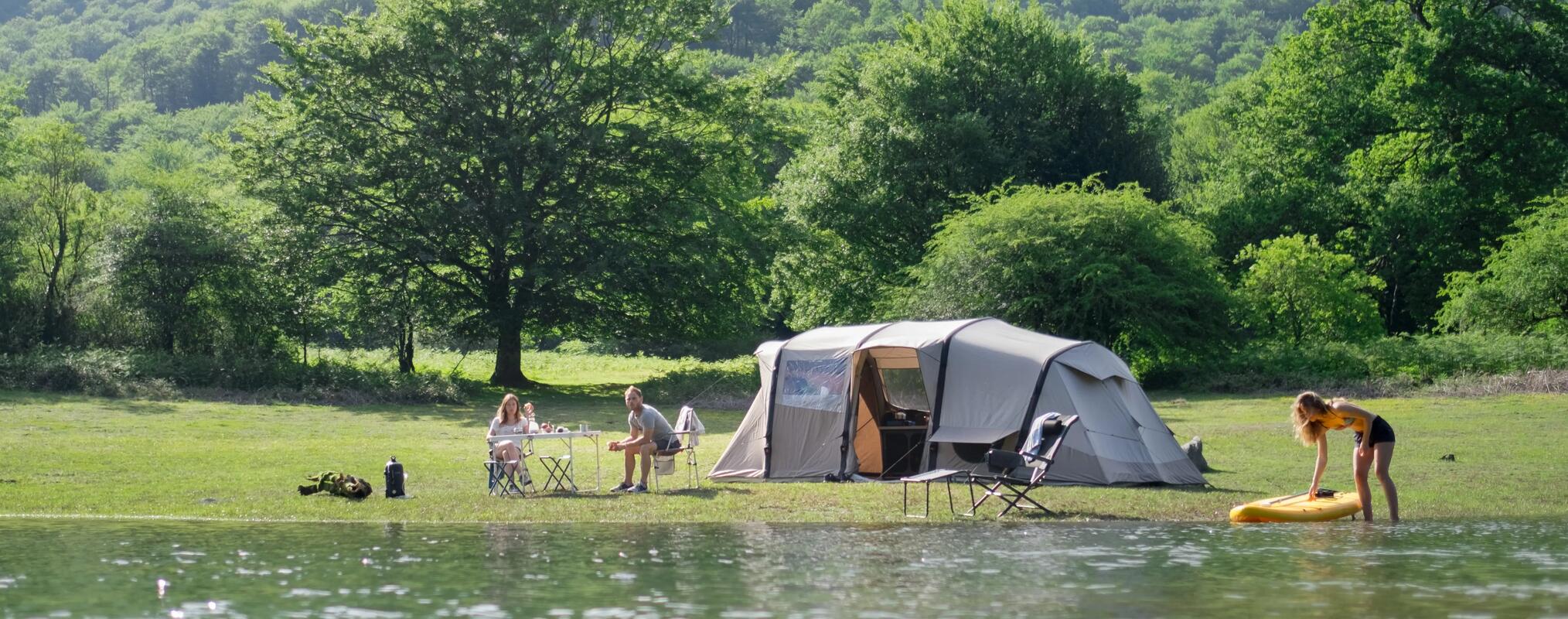
How to care for and store away your tent?
Your tent, a partner for your best weekends and vacations, may require some attention! Make sure to extend its
lifespan by providing regular care.
On this page, you’ll find all our tips for properly using and maintaining your tent.
With the help of Charlotte, product manager at the camp, we’re sharing all our tricks to ensure your
tent
accompanies you for as long as possible.
Summary
1. Using your tent
The first thing to do when caring for your tent is to use it properly.
Before pitching your tent, make sure that the front entrance is securely closed.
This will prevent you from over-stretching the canvas when you assemble the poles.
Also, even if the guy ropes are there to reinforce the resistance of your tent against the wind, there
is no point in stretching them too much.
You risk creating too much tension on the canvas.
A bit of advice?
Protect your tent from the sun
To prolong the lifespan of your tent for as long as possible, we advise you not to overexpose it to the sun.
In fact, UV rays may damage the canvas of your tent and accelerate its wear.
Our tents are designed to withstand an annual exposure of three consecutive weeks in the sun.
You can, of course, use your tent for more than three weeks a year!
But we recommend that you do not continuously expose it to UV rays, otherwise its wear will be greatly
accelerated.
2. How to properly wash your tent and which product to use
The easiest way to clean your tent is to brush it with clean water, making sure to use a soft brush: brushes
that are too hard can damage the canvas. You can, if necessary, use soapy water.
But we advise you to avoid cleaning products that could damage the canvas, as far as
possible.
You must then rinse your tent well so that no soapy residue remains.
To do this, a garden hose can be useful. Avoid high-pressure sprays that could damage the canvas and the
frame.
When it comes to the inside of your tent, the most effective is to use a dustpan and brush to remove small
stones, twigs and dust.
The worst enemy when caring for a tent
canvas?
Pine sap stains!
What must you do if you have resin on your tent canvas?
First of all, wait until the sap is
completely dry, then place an ice cube on the other side of the canvas where the sap stain is.
The
sap becomes brittle and comes off more easily if you scrape it gently.
Laundry-based canvas cleaning
can also give good results.
Be careful! The use of solvents greatly reduces the waterproof
qualities of tent fabrics.
Using them to clean your tent is therefore to be avoided!

Can you wash your tent in a washing machine?
This idea has undoubtedly crossed your mind, as it has ours.
But our engineers strongly advise
against this!
The multiple rubs of the canvas against the various tent elements (zips, cords,
etc.) caused by the rotation of the washing machine drum could damage the canvas and its coating.
Unfortunately, this calls for a bit of elbow grease!
3. Drying
Storing a tent that is still damp in its storage bag is the best way for mold to keep growing.
Even small, it will develop over time and it will then be difficult to get rid of.
It is therefore best to ensure that your tent is properly dried, either when you've
finished your camping or trekking trip, or once back home, by hanging it in the open air for a few hours.
Of course, the method should be adapted according to the space you have available!.
Are you lacking space?
The simplest solution is to separate your tent:double flysheet on one side, bedroom on the other.
Then
all you have to do is dry each item separately on a washing line, a clothes rack, the bar of a shower curtain,
a balcony...
If you have hung the bedroom and the flysheet on your balcony, you can use the guy ropes to
attach the whole thing to your balcony to avoid it falling
Do you have space outside?
You can pitch your tent when the weather is nice and dry.
If there's a little wind, it's even better !
Open the double roof doors and those of the bedroom (s).
All you have to do is wait for the sun
and the wind to do their job!
If you are in a hurry, you can use a squeegee (like those used for
swimming pools) to remove the water from your groundsheet.
Charlotte's advice, the camp product manager
"Remember to dry the underside of your tent well.The easiest way to do this is to fold your tent in half after removing the poles. This will allow you to dry the underside of your tent on one side and then the other. I also advise you to dry your tent cover well also! It would be a shame to store your dry tent in a damp cover ..."

4. Storage
Is your tent completely dry?
It’s now ready to be carefully folded away in its cover and then stored in a dry place at room
temperature.
To store it, remember to remove all the tent poles, including those installed above the front
entrance
as well as the reinforcement bars (especially present on big tents for four people or more).
It’s also important to close the front entrance of your tent securely when you store it.
Otherwise, your tent may be too tight when you unfold it again.

5. Reparation
You should know that the environmental impact of a discarded tent is equal to more than 3,000 km by car. In
order to limit this impact, all Quechua and Forclaz tents are repairable! Do you need to change a pole?Do you
need to replace a bedroom?
There are two solutions possible:
-
visit a DECATHLON store or contact DECATHLON customer service to have your tent examined and evaluated for
service.
Several services may be available depending on the case such as repairing the poles, changing the flysheet, etc. - find online the spare parts you need for your tent and repair it yourself!

How to properly maintain your polycotton tent?
The tent is made of natural but fragile materials. That's why it's important to know how to look after it.
As part of the tent is made of cotton, the canvas must be completely dry before storing it to prevent
mold.
So be careful about humidity!
On the other hand, it is important to keep the canvas clean and to clean the stains as quickly as
possible.
It is better to wipe off the dust with a soft brush.
What are the advantages of a polycotton tent?
Polycotton or also called Technical Cotton provides:
- better resistance to UV rays
- better breathability compared to a traditional polyester tent
- a longer lifespan
- a lighter tent than a 100% cotton one
- a more pleasant living environment in terms of noise, for example
However, you must be very careful because polycotton is a fabric that requires special attention when drying and cleaning stains on it.
The Airseconds 6.3 Polycotton tentOur motivation? To design an inflatable tent that is very easy to pitch and features our polycotton component for added comfort and durability! Insulating mat included to insulate from the cold. Long life to your tent!

How do you waterproof your tent?
When your tent is new, a certain level of waterproofing is displayed that must also be maintained. Ultraviolet rays, friction in its storage bag and natural wear and tear linked to contact with external elements require more or less frequent re-waterproofing, depending on its use. We therefore advise you to regularly (for example every year) apply a waterproofing spray on the outer fabric and the ground sheet of your tent, making sure not to forget the parts located at the seams.